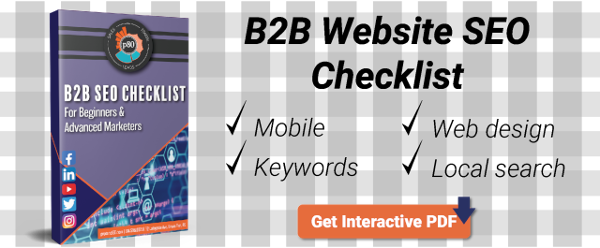Inbound Marketing Blog
for Manufacturers and Healthcare Companies
Over-optimization | When SEO Goes Sour
From the desk of p80’s Senior Inbound Marketing Specialist
Remember that one home maintenance project you took on a few years back?
You know the one – a necessary job that was supposed to be quick but instead it quickly became a nightmare.
Work took an entire Saturday. You made multiple trips to the hardware store. The tools you needed were never nearby. And you ended up calling in a professional to fix the mess.
We’ve all had that project (some of us, several times). What starts out as something routine and meant to make things better takes a nosedive into chaos. Despite your best intentions, you walk away from it no better off.
In some respects, website SEO (search engine optimization) is like regular home maintenance. When thoughtfully executed, SEO work upgrades your digital property, taking your site to new places. Handled haphazardly, SEO efforts leave your site in rough shape – and it’s not always immediately apparent.
Part of any traffic-driving and lead-producing digital marketing strategy, proper SEO implementation and maintenance ensures your site doesn’t fall into the infinite abyss of the Internet. Quite the opposite – done correctly, SEO keeps your site at the top of search engine results (ideally the #1 result on Google).
There is, however, a … dark side to SEO: Over-optimization.
Through over-optimization, a website and its contents (blogs, web pages) are about useful as unoptimized pieces. With SEO at an unnecessary level, your site finds its way to search engine results pages (SERP) that no one ever visits.
What is SEO?
SEO is the process of making sure your website and its content fulfill their purposes in driving traffic and nurturing leads.
Using a variety of tactics – some overt and others behind the scenes – SEO gives your website the best possible shot at getting noticed & ranked by Google and found online. Ideally, those who find your site are leads and future customers.
Base-level, yet effective, SEO best practices include:
- Copy with strategically selected keywords
- Catchy headings containing keywords
- Appropriate Meta descriptions
- Internal links
- External links
- Backlinks
- Intuitive website design
- A steady stream of new content
Combined, these best practices help move your website to the front of the line and appear before more eyes. Google not only sees your site as one that’s useful but also relevant and current.
What is Over-Optimization?
Over-optimization takes all the good things about SEO and ruins them (we’ll get into examples later).
Why is over-optimizing bad?
Rather than using SEO to make your website rank well and appear high up on a SERP, over-optimization is like a heavy anchor dragging it down.
With the help of complex algorithms, today’s search engines are intelligent. Unlike their 1995 versions, search engines understand, digest, and assign value to posted material (be it a blog or web page). When a search engine picks up on bad SEO and over-optimization, it downgrades a site's rankings.
6 Common Signs of an Over-Optimized Site
Too much of a good thing, over-optimization easily derails efforts to improve a website’s standing on the Internet.
When it comes to over-optimizing, what should you avoid when developing a search-optimized website? The most common bad SEO practices causing over-optimization include:
- Overused keywords (keyword stuffing)
- Keywords for the sake of keywords
- Pointless long-form blog articles
- Terrible title tags
- Weak link game
- Making too many SEO improvements at once
1. Overused Keywords (Keyword Stuffing)
Let’s use this piece as an example:
Actually, we better stop.
Did you notice how in a few sentences, the main keyword is used seven times? That’s called keyword stuffing – and Google doesn’t like that one bit. (Notice we made that paragraph an image so Google couldn’t read it and cite this piece).
Keyword stuffing occurs when you put the primary search term you’re writing about in a piece as many times as possible in hopes of a better ranking. Twenty years ago, that trick worked. Now, using the same keyword too many times knocks down your site's credibility and ranking position.
Resource: How to Optimize Keywords for Your Website
2. Keywords for the Sake of Keywords
Taking poor keyword use in a different direction, using too many keywords in a piece is another practice that costs your online content.
Most web pages and blog articles contain a plethora of keywords. Some occur naturally, while most are purposefully included based on research. These additional keywords – AKA, secondary keywords – offer a boost to the primary keyword. Carefully selected secondary keywords take a piece of content to the next level.
But just like overusing a primary keyword, inserting secondary keywords for the sake of it hurts your site’s rankings. Too many keywords overwhelm Google (yes, that’s possible), enough so that it has trouble discerning the purpose and meaning of your content.
In addition, shoehorning keywords into text doesn’t always work out well – sometimes it reads awkwardly. Remember: your website is made for humans, and as such, producing content that’s understandable matters.
3. Pointless Long-Form Blog Articles
Blog articles are a great way to get noticed by Google. A steady stream of appropriate keyword-rich content helps keep your site current and viewed by Google as a resource.
Generally speaking, Google prefers articles that are between 1,200 and 2,000 words – or what’s around a 10-minute read.
Long-form content beyond that range is often redundant and stretched. You’ll see it with huge, giant, run-on sentences that just keep going, and going, and going. And they’re typically followed by sentences that reiterate the same point in a huge, giant, run-on sentence that keeps going, and going, and going. In some instances, it seems like Yoda was the author.
Certainly, there’s a time and place for long-form articles – some topics are complex and need a lot of words. However, Google is smart enough to realize when a piece is being stretched to hit a word count.
4. Terrible Title Tags
Ever read a newspaper?
At the top of every story is a headline that tells you the topic of the piece in a few words.
Online, a web page or blog article’s title tags (headings or headers) tell search engines and their users what a piece of content is about. Keywordless headings, as well as those that don’t make sense, hurt your site. Headers that are too long and nonsensical header formatting throughout a piece drag your site down, too.
Google wants to quickly understand what a piece of content is about. If it’s even a little confused, you’ll see it in your rankings.
Best practices for solid headers include:
- Having a single H1 that’s no more than 70 characters
- Including the primary keyword in your H1 and at least one H2
- Using appropriate secondary keywords in subsequent headings
- Following a heading structure that makes sense. (Notice how this piece is formatted)
5. Weak Link Game
Links to both internal and external content do wonders for a web page’s SEO. Well-placed links tell Google a piece of content is part of a small ecosystem of useful resources.
However, internal links that only go to pages in a website’s main navigation menu are surface-level to Google. In other words, they don’t show Google much depth to a piece.
Even worse are toxic backlinks.
Backlinks are when another website links to yours or a piece of your content. Like internal and external links, they can do a lot of good for a piece. To Google, a backlink enhances your credibility. Toxic backlinks, on the other hand, come from questionable sources or are part of blackhat SEO techniques. When picked up by Google — you guessed it, your positioning on results pages goes down.
6. Making Too Many SEO Improvements at Once
Remember when we said it’s possible to overwhelm Google with too many keywords?
The same can happen when you do a massive overhaul of your website.
While an overhaul may indeed be in-line with best SEO practices, changing the majority of its content and structure is a lot to take in at once. In a sense, Google has to relearn your site.
That’s not to say a massive change should be implemented slowly – sometimes an immediate overhaul is long overdue. Rather, be aware that a high volume of changes will impact your site’s ranking for a little while.
Over-optimization | Avoiding SEO-No
In the constant battle for the #1 spot in a Google search, SEO is a powerful tool to keep your website and its contents in top form. However, over-optimization can ruin your site’s chances of reaching its full potential.
Carefully implemented and managed, ongoing website SEO sets a high bar for your competitors to reach.
Give Your Website an SEO Once-Over
Download our B2B SEO Checklist today:
Our Blogs, Direct to Your Inbox!
How to Audit your Online Marketing
If you are executing digital marketing, congratulations! You are most likely already one step ahead of your competition, and making strides to meaningfully connect with prospects online. But, how do you know if you’re seeing continual success year over year, and improving your metrics?
Without the tools in place to analyze and benchmark your efforts, it is impossible to scale your online marketing and ensure continuous success.




